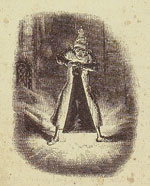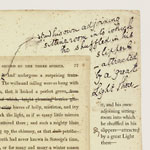On Stage with Charles Dickens
How did, then, A Christmas Carol become such a collective part of our Christmas traditions? “It’s a tale of redemption,” Gewirtz stated in a recent interview, “and everyone likes to feel that life offers second chances; third and fourth ones, too.”
The story came about years before Twain called Dickens “a bad reader,” before Mr. Fairbanks’ heart grew large enough to buy large fowl for his employees. It was 1843 when Dickens’ holiday novella was first published. He had wanted to write something about the destitute. He was disgusted with the social conditions of the poor–men, women and children–in the impoverished sections of London. The conditions were abysmal for the poor, particularly children. In 1839, just a few years before Dickens put pen to paper, half of all the funerals in London were for those under the age of ten.
Early in 1843, Dickens observed the appalling conditions of child laborers at tin mines in Cornish. He later witnessed the state of street kids, hungry and filthy, at the Field Lane Ragged School. Ideas began to foment in Dickens’ brain as he read Washington Irving’s Bracebridge Hall. Dickens enjoyed Irving’s descriptions of Christmas. Both men considered re-instituting traditional English Christmases as a way of promoting harmony, peace, and joy to a world ravaged by the machinations of the Industrial Revolution.
Dickens also needed a financial boost. At 31, he was the father of four. He thought he had written his finest novel, Martin Chuzzlewit, but the book’s sales were disappointing, and the publisher told him that they might have to cut his monthly advances. A fifth child was on the way, and he didn’t want his kids to feel the weight of poverty as he had when he was a child. His own father, John Dickens, was arrested in 1824 for debt and imprisoned in the Marshalsea, forcing young Charles to move near the prison, pawn his books, leave school, and accept employment at a shoe polish factory.
Dickens finished A Christmas Carol in six weeks of fevered writing in the fall of 1843. He wrote that he “wept and laughed, and wept again.” He later said of the novella’s creation, “I was very much affected by the little book” and “reluctant to set it aside for a moment.” With the holidays fast approaching, he completed the book in early December. The publisher, London’s Chapman & Hall, released it on December 19, bound in red cloth with gilt-edged pages, hand-colored etchings and black and white engravings by John Leech. The price was an affordable five shillings. The first run of 6,000 copies sold out by Christmas Eve, and the next printing sold exceedingly well through the New Year. Not only did regular Londoners like it, so did the critics. The book, noted William Makepeace Thackeray, was “a national benefit and to every man or woman who reads it, a personal kindness.”
It took some time for the book to be warmed by the hearths of American homes and in the hearts of American readers. Dickens had already written The Pickwick Papers, The Adventures of Oliver Twist, and The Life and Adventures of Nicholas Nickleby, but it was A Christmas Carol that made Dickens sensationally popular in the United States. The novella was widely circulated during the Civil War. In 1863, The New York Times wrote that Dickens’ book brought Christmas “into the living rooms of the poor of today.”
Dickens, for his part, tried to replicate his success with other Christmas stories in 1844, 1845, 1846, and 1848, though none had the critical or financial success of A Christmas Carol (though Dickens hardly earned an immense profit on the book due to the high production costs). So how else could Dickens reach a paying audience with his Christmas story? Public readings. Before Dickens, authors’ public readings were rare, but his works, most notably A Christmas Carol, lent themselves to performance (theatrical adaptations of A Christmas Carol were staged as early as February 1844). John Forster, Dickens’ friend and advisor, suggested to him that public exhibition for money was beneath the calling of a writer and a gentleman. In 1853, Dickens began giving public readings for charity; his first reading of A Christmas Carol was a smash. For years he continued his dramatic readings without remuneration, until he eventually became exasperated with so much work for no pay. On April 29, 1858, he gave his first paid performance. From then on, until he died in 1870, Dickens was a professional reader.










